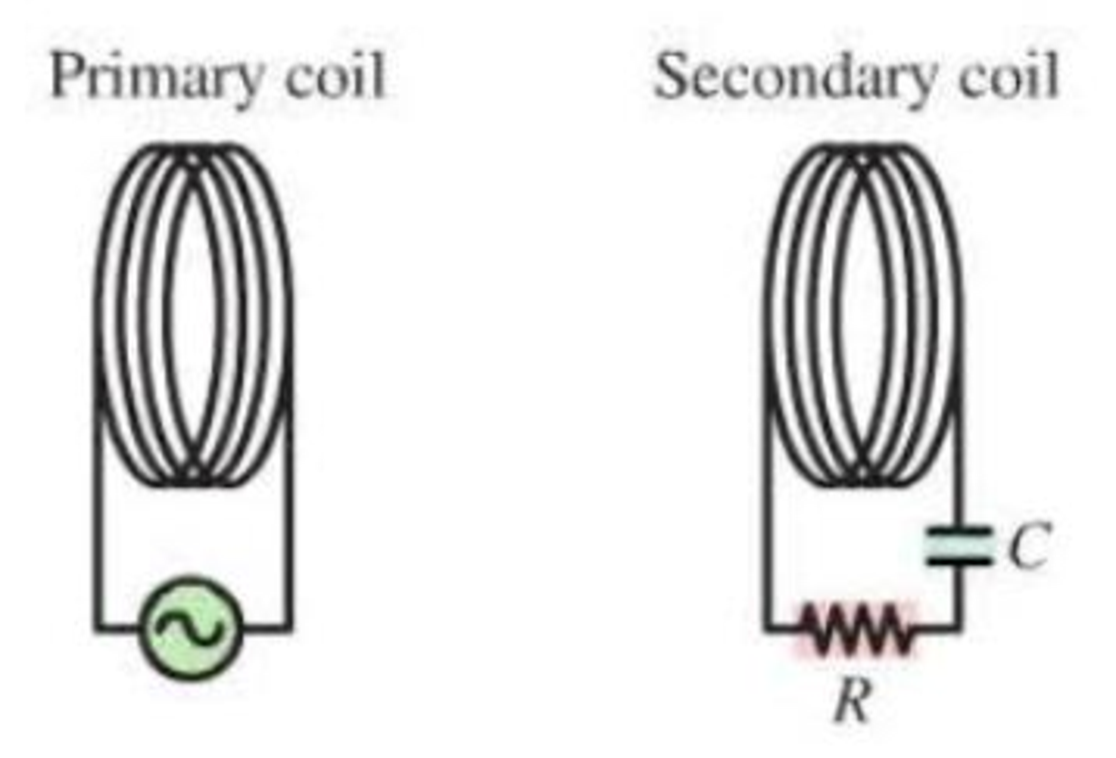
Wireless Power Transmission
Your laptop has wireless communications connectivity, and you might even have a wireless keyboard or mouse. But there’s one wire you haven’t been able to get rid of yet—the power cord.
Researchers are working on ways to circumvent the need for a direct electrical connection for power, and they are experiencing some success. Recently, investigators were able to use current lowing through a primary coil to power a 60 W lightbulb connected to a secondary coil 2.0 m away, with approximately 15% efficiency. The coils were large and the efficiency low, but it's a start.
Figure VI.2

The wireless power transfer system is outlined in Figure VI.2. An AC supply generates a current through the primary coil, creating a varying magnetic Held. This field induces a current in the secondary coil, which is connected to a resistance (the lightbulb) and a capacitor that sets the resonance frequency of the secondary circuit to match the frequency of the primary circuit.
What are the rms and peak currents for a 60 W bulb? (The rms voltage is the usual 120 V.)
- A. 0.71 A, 0.71 A
- B. 0.71 A, 0.50 A
- C. 0.50 A, 0.71 A
- D. 0.50 A, 0.50 A
Want to see the full answer?
Check out a sample textbook solution
Chapter P Solutions
College Physics: A Strategic Approach (3rd Edition)
Additional Science Textbook Solutions
Chemistry: An Introduction to General, Organic, and Biological Chemistry (13th Edition)
Microbiology: An Introduction
Laboratory Experiments in Microbiology (12th Edition) (What's New in Microbiology)
Campbell Biology: Concepts & Connections (9th Edition)
Human Physiology: An Integrated Approach (8th Edition)
Campbell Biology (11th Edition)
- No chatgpt plsarrow_forwardNo chatgpt pls will upvotearrow_forwardA shot putter releases a shot at 13 m/s at an angle of 42 degrees to the horizontal and from a height of 1.83 m above the ground. Calculate. Note: For each question draw a diagram to show the vector/s. Show all the steps and provide units in the answers. Provide answer to 2 decimal places unless stated otherwise. Answer all parts and show all work please.arrow_forward
- A player kicks a football at the start of the game. After a 4 second flight, the ball touches the ground 50 m from the kicking tee. Assume air resistance is negligible and the take-off and landing height are the same (i.e., time to peak = time to fall = ½ total flight time). Calculate: Note: For each question draw a diagram to show the vector/s. Show all the step and provide units in the answers. Provide answer to 2 decimal places unless stated otherwise.)arrow_forwardIf I stand next to a wall on a frictionless skateboard and push the wall with a force of 25 N, what would my acceleration be if my mass is 75 kg?arrow_forwardWhat is the direction of the magnetic force on the current shown in the following figures?arrow_forward
 College PhysicsPhysicsISBN:9781938168000Author:Paul Peter Urone, Roger HinrichsPublisher:OpenStax College
College PhysicsPhysicsISBN:9781938168000Author:Paul Peter Urone, Roger HinrichsPublisher:OpenStax College Glencoe Physics: Principles and Problems, Student...PhysicsISBN:9780078807213Author:Paul W. ZitzewitzPublisher:Glencoe/McGraw-Hill
Glencoe Physics: Principles and Problems, Student...PhysicsISBN:9780078807213Author:Paul W. ZitzewitzPublisher:Glencoe/McGraw-Hill Physics for Scientists and EngineersPhysicsISBN:9781337553278Author:Raymond A. Serway, John W. JewettPublisher:Cengage Learning
Physics for Scientists and EngineersPhysicsISBN:9781337553278Author:Raymond A. Serway, John W. JewettPublisher:Cengage Learning Physics for Scientists and Engineers with Modern ...PhysicsISBN:9781337553292Author:Raymond A. Serway, John W. JewettPublisher:Cengage Learning
Physics for Scientists and Engineers with Modern ...PhysicsISBN:9781337553292Author:Raymond A. Serway, John W. JewettPublisher:Cengage Learning
 Physics for Scientists and Engineers: Foundations...PhysicsISBN:9781133939146Author:Katz, Debora M.Publisher:Cengage Learning
Physics for Scientists and Engineers: Foundations...PhysicsISBN:9781133939146Author:Katz, Debora M.Publisher:Cengage Learning





